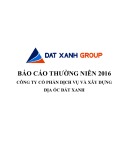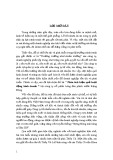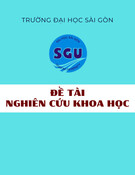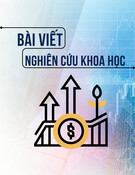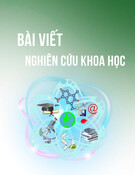
49 Journal of Economic and Banking Studies
No.7, Vol.4 (1), June 2024 pp. 49 - 63
© Banking Academy of Vietnam
ISSN 2734 - 9853
Green Human Resources Management: Review from
Theory to Empirical Research
Phan, Duc Dung - Nguyen, Huu Huynh
University of Economics and Law, Ho Chi Minh City, Vietnam
Corresponding Authors
E-mail address: dungpd@uel.edu.vn (Phan, D.D.), nguyenhh22707@sdh.uel.edu.vn (Nguyen, H.H.)
1. Introduction
Green human resource management
(HRM) plays a pivotal role in help-
ing organizations achieve their envi-
ronmental objectives (Paillé et al., 2014). It
is widely acknowledged as one of the most
effective means to foster positive relationships
between organizations and their stakeholders
(Yusoff et al., 2020). Green HRM practices
contribute significantly to meeting sustainable
requirements related to social justice, health,
welfare, and the overall well-being of both
the organization and its employees, all while
achieving economic stability and environ-
mental balance (Amrutha and Geetha, 2020).
Green human resource management represents
the integration of environmental management
with activities associated with human resource
management (Malik et al., 2021). This ap-
proach stands as a pathway for organizations
to advance by reducing operational costs while
simultaneously retaining valuable employees,
thereby enhancing productivity, improving
management effectiveness, and ultimately
positioning themselves for profitability and a
competitive edge (Malik et al., 2021). Green
HRM is dedicated to utilizing human resource
management processes and guidelines to
ensure sustainable resource utilization and to
robustly champion environmentalism (Vahdati
and Vahdati, 2018).
Chronicle Abstract
Article history This study aims to provide a comprehensive understanding of green human
resource management by examining, analyzing, and synthesizing findings
from 109 empirical studies conducted worldwide. These studies were pub-
lished between 2017 and July 2023. The findings of this study revealed that
the examination of green human resource management predominantly re-
volves around two perspectives: business assessment and employee assess-
ment. When viewed from a business perspective, research in green human
resource management encompasses the following categories of factors: (i)
Environmental impact; (ii) Business operations impact; and (iii) Corporate
efficiency impact. On the other hand, when approached from the employee
perspective, it focuses on factors such as: (i) Employee environmental be-
havior; (ii) Employee performance; (iii) Miscellaneous factors. Quantitative
research methods were commonly employed in these studies, with a pri-
mary focus on surveying employees. The findings from this research play a
crucial role in providing future researchers with a comprehensive overview
of the green human resource management field. Furthermore, we suggest
potential avenues for future research in this area.
Received
Revised
Accepted
29th Oct 2023
02nd Apr 2024
26th Apr 2024
Keywords
Business assessment;
Employee assessment;
Green human resources
management;
Literature review
DOI:
10.59276/JEBS.2024.06.2615

Green Human Resources Management: Review from Theory to Empirical Research
50
Journal of Economic and Banking Studies- No.7, Vol.4 (1), June 2024
Given the growing trend of green human
resource management in recent years, this
topic has garnered significant scholarly atten-
tion. For instance, Amrutha and Geetha (2020)
conducted a systematic review of 174 stud-
ies spanning from 1995 to 2019, proposing a
research model linking green human resource
management to social sustainability. Similarly,
Yong et al. (2020) provided an overview of
70 articles on green human resource manage-
ment from 2007 to 2019. Santana et al. (2020)
reviewed 194 studies conducted between 2006
and 2019 to explore the relationship between
social responsibility and green human resource
management. Cooke et al. (2020) conducted
a comprehensive review of green human
resource management research spanning 25
years in Asia. Anlesinya and Susomrith (2020)
conducted an overview of 122 studies from
2003 to 2020, with the majority of them focus-
ing on the topic of sustainability. Additionally,
Mukherji and Bhatnagar (2022) conducted a
review of recent concepts and theories related
to green human resource management while
exploring its connection with sustainability.
Drawing from prior research on green HRM,
studies in this field primarily focus on assess-
ing (Anlesinya and Susomrith, 2020), analyz-
ing (Cooke, Schuler and Varma, 2020), identi-
fying emerging research trends (Yong, Yusliza
and Fawehinmi, 2020), or exploring specific
relationships (Amrutha and Geetha, 2020;
Santana, Morales-Sánchez and Pasamar, 2020).
However, there is a noticeable dearth of com-
prehensive investigations into the overarching
influence of green human resource manage-
ment on both company operations and employ-
ee performance. This research gap serves as the
primary impetus for conducting this literature
review. To address this research void, we have
formulated the following research question:
“What is the overall impact of green human
resource management on both company opera-
tions and employee performance as explored
in existing research?”. Our research endeavors
are aimed at addressing this question.
This article is organized as follows: Section 2
outlines the research methodology. In Section
3, we provide a comprehensive overview of
the literature, summarizing previous studies.
Section 4 categorizes the factors influenced by
green human resources management. Follow-
ing that, Section 5 delves into the research
findings and draws conclusions. Finally, Sec-
tion 6 serves as the conclusion, where we also
offer recommendations for future research.
2. Research method
In this study, we utilize the systematic litera-
ture review methodology to explore research
concerning the comprehensive effects of green
human resource management on both com-
pany operations and employee performance.
The systematic literature review methodology
involves several key steps: (i) formulating a
research question, (ii) identifying pertinent
literature, (iii) selecting studies, (iv) appraising
the selected studies, (v) synthesizing findings,
and (vi) reporting the review. This study as-
sessed previous research on the topic using the
following criteria: (1) Peer-reviewed articles,
(2) Articles published from 2017 to 2023, and
Table 1. Flow for Systematic Review
No. Content n
1
Records identified through
database search
1,635
Google Scholar 989
Scopus 385
Science Direct 261
2
Records after duplicates
removed
1,374
3Records screened 546
Records excluded 382
4
Full-text articles assessed for
eligibility
164
Full-text articles excluded, with
reasons
55
Out of scope 21
Insufficient detail 34
5
Studies included in qualitative
synthesis
109
Source: Review results

Phan, Duc Dung - Nguyen, Huu Huynh
51
No.7, Vol.4 (1), June 2024- Journal of Economic and Banking Studies
(3) Articles focused on green human resource
management. Relevant studies were gathered
from databases, storage systems, and popular
websites, including Scopus, Science Direct,
and Google Scholar. We used keywords such
as “Green Human Resources Management”
and “Determinants of Green Human Resources
Management” to search for titles and keywords
in these databases. Additionally, our systematic
reviews are meticulously presented in Table 1,
offering clarity and comprehensiveness. The
table illustrates the systematic review process
for green human resource management, outlin-
ing the steps of identification, selection, and
exclusion of studies. Initially, 1,635 records
were identified from diverse sources. After
eliminating duplicates, 1,374 records were
excluded. Through the screening of titles and
abstracts, 546 records were excluded. Follow-
ing a thorough full-text review, 437 records
were further excluded, resulting in a final
review comprising 109 studies.
We evaluated 109 studies based on the under-
lying theories employed, the research subjects,
research areas, research methods, research
data, and factors related to the topic of green
human resource management. The number of
published studies is presented in Figure 1.
3. Literature review on effect of green
human resource management on business
and employees
In this section, we describe research trends in
green human resource management, based on
two main perspectives: businesses and employ-
ees.
3.1. Studies on green human resources man-
agement: An aspect of businesses
Research on Green Human Resource Manage-
ment, from a business perspective, primarily
investigates its influence on environmental,
operational, and corporate performance factors.
3.1.1. Research on the effect of green HRM on
environmental factors
Environmental factors are categorized into two
groups: environmental efficiency and environ-
mental sustainability.
Environmental efficiency refers to organiza-
tional initiatives that not only meet but also
exceed societal expectations regarding the
natural environment (Singh et al., 2020). It
encompasses the environmental impacts of
an organization’s processes, products, and
resource consumption, aligning them with en-
vironmental regulatory requirements (Dubey et
al., 2015). Numerous studies have highlighted
the positive influence of green human resource
management on environmental performance.
Source: Review results
Figure 1. Number of published articles

Green Human Resources Management: Review from Theory to Empirical Research
52
Journal of Economic and Banking Studies- No.7, Vol.4 (1), June 2024
For instance, Saeed et al. (2021) conducted a
survey of 269 managers at manufacturing com-
panies in Pakistan, confirming the beneficial
impact of green human resource management
on environmental performance. Additionally,
Saeed et al. (2021) identified green supply
chain management factors that can moderate
the relationship between green human resource
management and environmental performance.
Similarly, Aftab et al. (2023) surveyed 410
managers in manufacturing enterprises in Paki-
stan and demonstrated a positive relationship
between green human resource management
and environmental performance. Likewise,
Awan et al. (2023) surveyed 315 small and
medium-sized enterprises in the manufactur-
ing industry in China, concluding that green
human resource management positively influ-
ences the environmental performance of these
enterprises. Furthermore, Awan et al. (2023)
also identified green transformational leader-
ship factors that can moderate the impact of
green human resource management on envi-
ronmental performance.
Environmental sustainability sets the overarch-
ing direction for all realms of human and busi-
ness activity (Hojnik et al., 2022). It is widely
acknowledged as a form of development
that prioritizes the well-being of future gen-
erations and avoids harm to the environment
(Yasin et al., 2023). Achieving sustainability
in the corporate sphere hinges on organiza-
tions considering all stakeholders within their
business model (Konietzko et al., 2020). In a
study conducted by Yasin et al. (2023), which
surveyed 329 employees at textile enterprises
in Pakistan, it was demonstrated that green
human resource management has a positive
correlation with the overall sustainability of the
enterprise.
For more details, please refer to Table 2.
3.1.2. Research on the effect of green HRM on
operational factors
Business activities factors are categorized into
three main groups: social responsibility, green
innovation activities, and various other factors.
Corporate social responsibility entails applying
a set of principles aimed at achieving a balance
among the interests of all stakeholders, includ-
ing suppliers, society, and consumers/custom-
ers (Fernández-Guadaño and Sarria-Pedroza,
2018). It is also a crucial factor in fostering
business competitiveness, sustainable growth,
and the attainment of organizational goals and
strategies (Sabokro et al., 2021). Yasin et al.
(2023) have demonstrated the positive impact
of green human resource management on cor-
porate social responsibility.
Green innovation refers to innovation aimed
at reducing environmental impacts while
achieving corporate environmental goals and
providing environmental benefits (Lin et al.,
2014). In a survey conducted by Munawar et
al. (2022) involving 209 employees in hotels
in Pakistan, it was concluded that green human
resource management has a positive impact
on green innovation activities. Similarly,
Song et al. (2021) surveyed 103 enterprises in
China, revealing a positive relationship be-
tween green human resource management and
green innovation activities. However, Singh
et al. (2020) argue that green transformational
leadership factors have a moderating effect on
the relationship between green human resource
management and green innovation activities.
Other factors positively influenced by green
human resource management encompass orga-
Table 2. Studies using environmental factors as a dependent variable
Variable Studies
Environmental efficiency
Gilal et al. (2019), Singh et al. (2020), Aftab et al. (2023), Saeed et
al. (2021), Shafaei et al. (2020), Awan et al. (2023), Priyangaa and
Priyashantha (2022), Umrani et al. (2022), Muisyo and Qin (2021)
Environmental sustainability Yasin et al. (2023)
Source: Review results

Phan, Duc Dung - Nguyen, Huu Huynh
53
No.7, Vol.4 (1), June 2024- Journal of Economic and Banking Studies
nizational sustainability (Amjad et al., 2021),
green supply chain management (Nejati et al.,
2017), and organizational reputation and at-
tractiveness (Merlin and Chen, 2022).
For more details, please refer to Table 3.
3.1.3. Research on the effect of green HRM on
corporate performance factors
Factors related to organizational effectiveness
are categorized into two groups: organizational
effectiveness and sustainable effectiveness, as
follows.
Organizational effectiveness is a central con-
cept in management, encompassing various
methods developed by experts to describe and
measure it (Lee et al., 2019). The effective-
ness of an organization can be assessed based
on two key attributes: its “ability to maintain
long-term profits and market share”, and its
“ability to compete with other organizations”
(Al-Qudah et al., 2020). In a survey conducted
by Mahmood et al. (2023) involving 189
employees in businesses in Pakistan, it was
demonstrated that big data analytics can posi-
tively moderate the relationship between green
human resource management and employee
organizational performance.
Sustainable performance encompasses eco-
nomic, social, and environmental aspects
(Chardine-Baumann and Botta-Genoulaz,
2014). In a survey conducted by Mousa and
Othman (2020) involving 65 managers at
healthcare enterprises in Palestine, it was dem-
onstrated that green human resource manage-
ment positively impacts the organization’s sus-
tainable performance. Similarly, Obeidat et al.
(2023) also confirmed a positive relationship
between green human resource management
and sustainable organizational performance in
service enterprises in Qatar.
For more details, please refer to Table 4.
3.2. Studies on green human resources man-
agement: An aspect of employees
Research on Green Human Resource Manage-
ment from the employee perspective primarily
investigates its impact on three main groups of
factors: employee behavior toward the envi-
ronment, employee performance, and other
factors.
3.2.1. Research on the effect of green HRM on
employee behavior toward the environment
Factors related to employee behavior toward
the environment are categorized into three
main groups: employee green behavior, em-
ployee environmental behavior, and various
other factors.
Green employee behavior is increasingly
encouraged in many organizations due to
growing concerns about the environment and
Table 3. Studies using operational factors as a dependent variable
Variable Studies
Green innovation activities Song et al. (2021), Munawar et al. (2022)
Corporate social responsibility Sabokro et al. (2021), Yasin et al. (2023)
Organizational sustainability Amjad et al. (2021)
Green supply chain management Nejati et al. (2017)
Organizational reputation and attractiveness Merlin and Chen (2022)
Source: Review results
Table 4. Studies using corporate performance factors as a dependent variable
Variable Studies
Sustainable performance Mousa and Othman (2020), Obeidat et al. (2023)
Organizational effectiveness Mahmood et al. (2023)
Source: Review results


